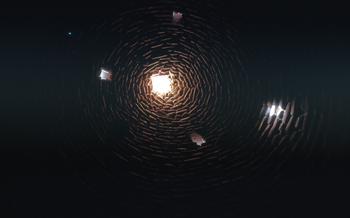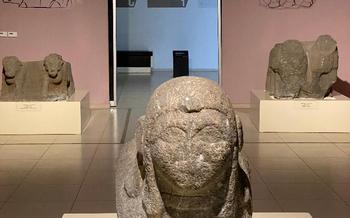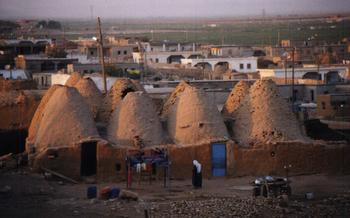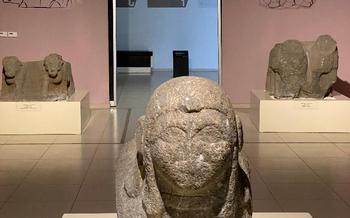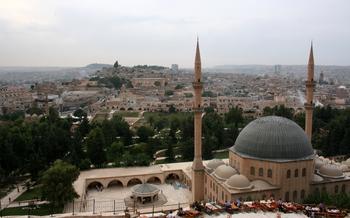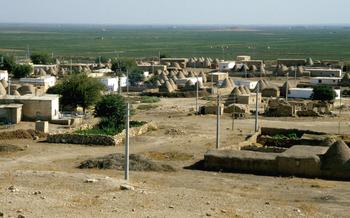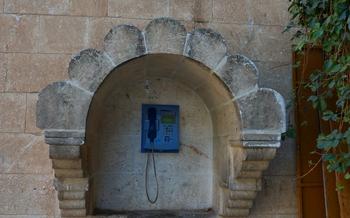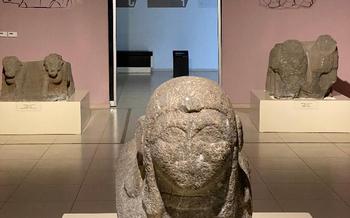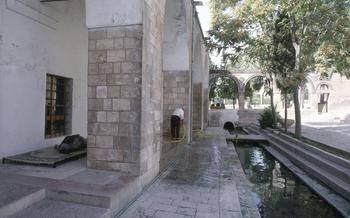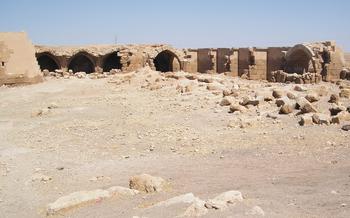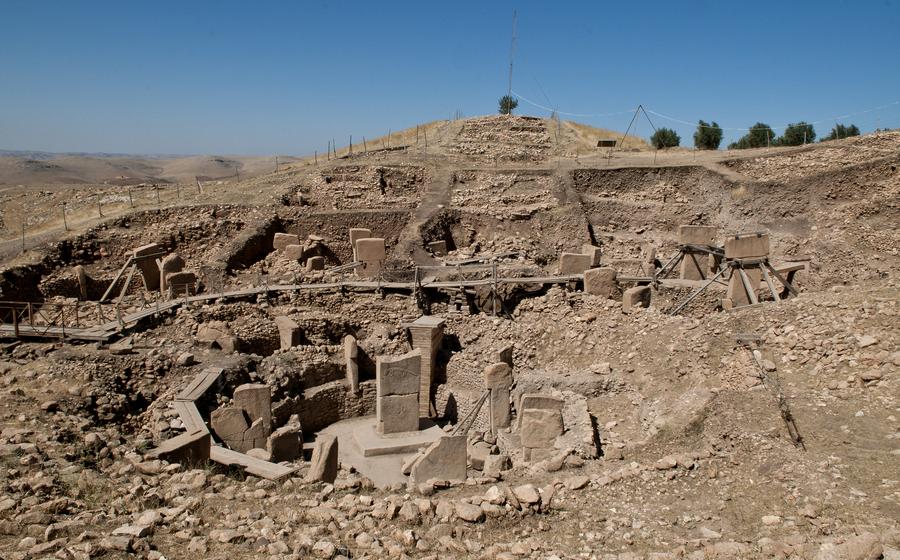
Göbekli Tepe
- Göbekli Tepe: A Historical Marvel
- Location and Accessibility
- History and Background
- Unique Features and Structures
- Göbekli Tepe Museum: Unraveling the Mysteries of the Past
- Visitor Experience
- Nearby Attractions
- Local Cuisine and Dining
- Accommodation Options
- Photography and Videography
- Ethical and Responsible Tourism
- Travel Tips and Practical Advice
- Suggested Itineraries
- Cultural Insights and Traditions
- Insider Tip: Unveiling the Secrets of the Pillars
Göbekli Tepe: A Historical Marvel
Göbekli Tepe, nestled in the heart of Şanlıurfa, Turkey, is an archaeological marvel that has captivated the world's attention. It is the oldest known temple in human history, dating back to a staggering 11,000 years ago. This awe-inspiring site predates the construction of the Egyptian pyramids and Stonehenge, making it a testament to the ingenuity and sophisticated culture of our ancestors.
Göbekli Tepe's discovery has revolutionized our understanding of human history. It challenges traditional theories about the origins of civilization and sheds light on the remarkable achievements of our prehistoric predecessors. The mysterious builders of Göbekli Tepe possessed advanced knowledge of architecture, engineering, and astronomy, constructing a complex and monumental structure that has stood the test of time.
The ongoing excavations at Göbekli Tepe continue to reveal new discoveries and insights. Archaeologists have unearthed intricate carvings and reliefs depicting animals, humans, and abstract symbols, offering glimpses into the beliefs and rituals of the ancient inhabitants. These enigmatic carvings hint at a sophisticated system of mythology and religion that predates any known written language.
Göbekli Tepe is not just a historical site; it is a portal to a forgotten world, where we can trace the roots of our civilization and marvel at the ingenuity of our ancestors. A visit to this ancient sanctuary is a journey through time, allowing us to connect with the distant past and gain a deeper appreciation for our shared human heritage.
Location and Accessibility
Göbekli Tepe is situated in the Örencik village, approximately 18 kilometers northeast of the city of Şanlıurfa in southeastern Turkey. It lies within the boundaries of the Harran Plain, a fertile region known for its rich history and cultural heritage. Reaching Göbekli Tepe is relatively straightforward, with several transportation options available.
For those traveling by public transport, regular buses depart from Şanlıurfa city center to Örencik village, making it a convenient and affordable option. The journey takes about 30-40 minutes, and buses are equipped with comfortable seating and air conditioning. Alternatively, visitors can opt for the scenic route by hiring a car or joining an organized tour.
Driving to Göbekli Tepe offers the flexibility to explore the surrounding area at your own pace. The well-maintained roads allow for a smooth and enjoyable journey. The distance from Şanlıurfa city center to the site is approximately 20 kilometers, and the drive takes around 25 minutes.
Organized tours are a popular choice for those seeking a comprehensive and hassle-free experience. These tours typically include round-trip transportation from major cities like Istanbul, Ankara, and Antalya, as well as guided visits to Göbekli Tepe and other nearby attractions. Guided tours provide valuable insights into the history and significance of the site, making them a great option for history enthusiasts and first-time visitors.
History and Background
Göbekli Tepe's origins are shrouded in mystery, making it a captivating subject for archaeologists and historians worldwide. The site was constructed during the Neolithic period, approximately 11,000 years ago, predating the invention of pottery and agriculture. This remarkable discovery challenges our understanding of Neolithic societies and suggests the existence of advanced pre-agricultural communities.
Tracing the timeline of Göbekli Tepe's construction and abandonment reveals a complex narrative. The site was built in several phases, with different structures erected over time. It is believed that Göbekli Tepe served as a ceremonial center or a religious sanctuary for hunter-gatherer communities. The site's abandonment, around 8000 BC, remains a subject of debate, with various theories suggesting climate change, resource depletion, or cultural shifts as possible causes.
Archaeological excavations at Göbekli Tepe have been ongoing since the 1990s, led by German archaeologist Klaus Schmidt. These excavations have unearthed a wealth of artifacts and structures, including the iconic T-shaped pillars, intricate carvings, and circular enclosures. The site's exceptional preservation and the ongoing discoveries continue to shed light on the Neolithic period and the origins of human civilization.
Unique Features and Structures
Göbekli Tepe stands out for its array of unique features and structures that have captivated archaeologists and scholars worldwide. The most striking aspect of the site is its collection of T-shaped pillars, arranged in concentric circles. These massive stone structures, some weighing up to 50 tons, are adorned with intricate carvings and reliefs depicting a variety of animals, including lions, bulls, foxes, and birds. These carvings suggest that the pillars had a symbolic or ritualistic significance, possibly related to hunting or fertility.
In addition to the T-shaped pillars, Göbekli Tepe features several circular enclosures, which are believed to have been used for gatherings or ceremonies. The largest of these enclosures, known as the "Great Enclosure," has a diameter of over 20 meters and is surrounded by a double row of pillars. The function and purpose of these enclosures remain a mystery, but their size and elaborate construction suggest that they played an important role in the lives of the people who built Göbekli Tepe.
The site also contains a number of smaller structures, including a number of smaller stone circles and rectangular buildings. These structures may have been used for a variety of purposes, such as storage, housing, or animal pens.
The unique features and structures of Göbekli Tepe provide valuable insights into the beliefs and practices of the people who built it. The site's T-shaped pillars, circular enclosures, and intricate carvings suggest that Göbekli Tepe was a place of great ritual and symbolic importance.
Göbekli Tepe Museum: Unraveling the Mysteries of the Past
A visit to Göbekli Tepe is incomplete without exploring the on-site museum, which serves as a treasure trove of artifacts and insights into the ancient world. Established in close proximity to the archaeological site, the museum houses a remarkable collection of findings unearthed during the excavations.
Interactive displays and educational resources provide visitors with an immersive experience, allowing them to delve deeper into the history, significance, and ongoing research surrounding Göbekli Tepe. The museum's exhibits showcase a range of artifacts, including intricately carved stone tools, pottery fragments, and animal bones, offering a tangible connection to the lives of the people who inhabited this sacred site thousands of years ago.
Through its comprehensive displays and informative panels, the Göbekli Tepe Museum plays a crucial role in preserving and interpreting the site's rich cultural heritage. It serves as a vital resource for scholars and enthusiasts alike, contributing to the ongoing efforts to unravel the mysteries of this enigmatic ancient wonder.
Visitor Experience
Visiting Göbekli Tepe is a unique and enriching experience that offers a glimpse into the distant past. To make the most of your visit, plan ahead and consider the following tips:
Preparation: Before your trip, research the site's history, significance, and ongoing excavations. This will enhance your understanding and appreciation of what you see.
Timing: Aim to visit Göbekli Tepe in the spring or fall when the weather is pleasant. Avoid the scorching summer heat and the cold winter months.
Guided Tours: Guided tours are highly recommended as they provide valuable insights and explanations from knowledgeable experts. Book your tour in advance to secure a spot.
Facilities: The site has basic facilities such as restrooms and a small cafe. However, it's advisable to bring your own water and snacks, especially if you plan to spend several hours exploring.
Respect: Remember that Göbekli Tepe is an active archaeological site. Respect the ongoing excavations and refrain from touching or climbing on the ancient structures.
Photography: Photography is generally allowed at Göbekli Tepe, but using a flash is prohibited as it can damage the delicate carvings. Respect the site's rules and guidelines regarding photography.
Nearby Attractions
Göbekli Tepe, although remarkable in its own right, is not the only historical treasure in the region. Take advantage of your visit to explore other captivating sites nearby.
Just a short drive away lies Harran, a town steeped in history, famous for its unique beehive houses, dating back to the time of Abraham. These remarkable structures, made of mud and straw, provide a glimpse into ancient architectural ingenuity and offer a fascinating insight into the region's rich past.
Şanlıurfa, the nearby city, is also worth exploring. Delve into the ancient city's history at the Şanlıurfa Archaeological Museum, housing artifacts from Göbekli Tepe and other significant excavations. Discover the legendary Pool of Abraham, a sacred site with a captivating story rooted in local folklore.
Combine your visit to Göbekli Tepe with a journey to Mount Nemrut, located about 200 kilometers away. Witness the awe-inspiring colossal statues of ancient gods, perched atop the mountain peak, offering an unforgettable experience.
Take this opportunity to immerse yourself in the region's cultural heritage. Each of these destinations offers a unique perspective on the history and traditions of this captivating corner of Turkey, making for a truly enriching experience.
Local Cuisine and Dining
Şanlıurfa's culinary scene is a vibrant tapestry of flavors and aromas, offering a unique gastronomic experience. As you explore Göbekli Tepe, take the opportunity to tantalize your taste buds with the region's traditional cuisine.
Indulge in the delectable çiğ köfte, a zesty mixture of minced meat, bulgur, spices, and herbs, often accompanied by crisp lettuce leaves. Savor the sizzling lahmacun, a thin dough topped with minced meat, tomatoes, peppers, and aromatic spices, baked to perfection in a traditional stone oven.
For a hearty meal, try the Urfa kebabı, succulent chunks of grilled meat served with rice, grilled tomatoes, and peppers. Vegetarians will delight in the array of meze platters, featuring a variety of dips, salads, and pickled vegetables.
Be sure to sample the local Şanlıurfa cheese, renowned for its distinct flavor and texture. Wash down your meal with a refreshing glass of ayran, a yogurt-based drink, or indulge in the sweet temptation of künefe, a crispy pastry filled with melted cheese and topped with a sugary syrup.
To fully immerse yourself in the local culinary culture, venture into the bustling markets and discover the freshest ingredients, spices, and sweets. Engage with the friendly locals, who will gladly share their culinary secrets and guide you towards the hidden gems of Şanlıurfa's gastronomic world.
Accommodation Options
When planning your trip to Göbekli Tepe, choosing the right accommodation is crucial for a comfortable and enjoyable stay. Several options are available near the site, catering to different budgets and preferences.
In Şanlıurfa, a range of hotels and guesthouses offer a variety of options, from budget-friendly hostels to luxurious accommodations. For a truly immersive experience, consider staying in a traditional Turkish guesthouse, where you can relish local hospitality and savor authentic cuisine.
If you prefer to be closer to the site, several hotels and lodges are situated within a short driving distance of Göbekli Tepe. These accommodations often provide stunning views of the surrounding landscape and offer convenient access to the ancient ruins.
For a unique and adventurous experience, camping facilities are available near the site, allowing you to immerse yourself fully in nature. Organized tours often include camping options, providing a hassle-free way to explore the region.
When budgeting for accommodation, consider factors such as the time of year, the duration of your stay, and your desired level of comfort. Peak season (April-October) typically commands higher prices, so booking in advance is advisable.
Whether you choose to stay in Şanlıurfa or near Göbekli Tepe, ensure that you make reservations in advance, especially if traveling during the busy summer months. The availability of accommodation can be limited, particularly for popular tour dates.
Photography and Videography
With its unique structures and captivating history, Göbekli Tepe offers a treasure trove of opportunities for photography and videography enthusiasts. Capturing the essence of this ancient site through your lens can be a rewarding experience, allowing you to share its beauty and significance with others.
Permits and Regulations: Before embarking on your photography or videography journey at Göbekli Tepe, it's essential to be aware of the site's regulations. While photography and videography are generally permitted, obtaining a permit from the site's administration is required. This helps ensure the preservation and protection of the site for future generations.
Getting the Best Shots: To capture the best shots of Göbekli Tepe, consider visiting during the golden hours of sunrise or sunset when the light is most flattering. Use a wide-angle lens to capture the expansive views of the site and its surroundings. Experiment with different angles and perspectives to convey the scale and grandeur of the structures.
Sharing Your Experiences: After capturing your stunning shots and videos, don't forget to share them with the world! Use social media platforms like Instagram, Facebook, or YouTube to showcase your work and inspire others to visit this incredible site. Remember to tag the official Göbekli Tepe accounts and use relevant hashtags to reach a wider audience.
Ethical and Responsible Tourism
As you embark on your journey to Göbekli Tepe, it is crucial to embrace responsible tourism practices. This ancient site holds immense cultural and historical significance, and it is our collective responsibility to preserve and protect it for generations to come. Here are some guidelines to follow:
-
Respect the Site's Heritage: Göbekli Tepe is not just an archaeological site; it is a symbol of humanity's shared past. Refrain from touching or climbing on the structures, as this can damage the delicate ruins.
-
Minimize Environmental Impact: Be mindful of your ecological footprint by using reusable water bottles, avoiding single-use plastics, and disposing of waste responsibly.
-
Support Local Communities: Choose local guides and services to support the economy and create opportunities for the people who live in the area.
-
Respect Local Customs: Turkey is a predominantly Muslim country, so it is important to dress and behave respectfully. Be mindful of local customs, such as avoiding public displays of affection or revealing clothing.
-
Engage with Locals: Take the time to interact with the local people and learn about their culture and traditions. This will not only enrich your experience but also promote cross-cultural understanding.
By embracing ethical and responsible tourism practices, we can ensure that Göbekli Tepe remains a source of inspiration and wonder for generations to come.
Travel Tips and Practical Advice
To ensure a smooth and enjoyable visit to Göbekli Tepe, consider the following travel tips:
- Pack essentials: Comfortable footwear is a must for walking around the site. Sun protection, including sunscreen, sunglasses, and a hat, is essential, especially during the summer months. A camera is a must-have for capturing the unique features of Göbekli Tepe.
- Currency exchange: The Turkish Lira (TRY) is the official currency of Turkey. It's advisable to exchange your currency before your trip or use a credit/debit card with international transaction capabilities.
- Language barriers: English is not widely spoken in the area, so it's helpful to learn a few basic Turkish phrases or carry a translation app.
- Communication strategies: If you encounter language difficulties, gestures, body language, and patience can help bridge the communication gap.
- Local customs: Respect local customs and traditions. Dress modestly and avoid revealing clothing, especially when visiting religious sites.
- Safety precautions: Göbekli Tepe and the surrounding area are generally safe, but it's always advisable to take standard safety precautions, such as being aware of your surroundings and keeping your valuables secure.
Suggested Itineraries
Crafting a personalized itinerary for your journey to Göbekli Tepe is essential to make the most of your visit. Whether you have a day or several days to explore, there are various options to suit your interests and time constraints.
Day Trip Itinerary:
- Morning: Embark on a guided tour of Göbekli Tepe to delve into its history and significance. Immerse yourself in the ancient atmosphere and marvel at the T-shaped pillars and intricate carvings.
- Afternoon: Visit the on-site museum to gain further insights into the findings from the excavations. Explore the artifacts and exhibits, and engage with the interactive displays to deepen your understanding of Göbekli Tepe's role in human history.
- Evening: Indulge in the local cuisine of Şanlıurfa by sampling traditional dishes like çiğ köfte and lahmacun at a renowned restaurant. Take a leisurely stroll through the city center, soaking in the vibrant atmosphere and local culture.
Multi-Day Itinerary:
- Day 1: Dedicate the entire day to exploring Göbekli Tepe. Take your time to wander through the site, admiring the unique structures and immersing yourself in its ancient aura. Participate in a guided tour to uncover the mysteries and theories surrounding this enigmatic place.
- Day 2: Discover the nearby attractions in the region. Visit Harran, renowned for its distinctive beehive houses, and explore the ancient city of Şanlıurfa, where you can delve into its rich history and cultural heritage.
- Day 3: Embark on a day trip to Mount Nemrut, a UNESCO World Heritage Site. Marvel at the colossal statues of ancient gods and soak in the breathtaking panoramic views from the summit.
Customizing Your Itinerary:
- For those with specific interests, consider exploring other historical sites in the vicinity, such as the Zeugma Mosaic Museum or the Şanlıurfa Archaeological Museum.
- If time permits, combine your visit to Göbekli Tepe with other regional attractions like Gaziantep, known for its culinary delights, or Mardin, a city steeped in history and culture.
- Tailor your itinerary to suit your pace and preferences, ensuring a fulfilling and memorable experience in Şanlıurfa.
Cultural Insights and Traditions
Şanlıurfa, the region where Göbekli Tepe is located, offers a rich tapestry of cultural insights and traditions. It's essential to respect local customs and religious beliefs while traveling in the area. Refrain from wearing revealing clothing or behaving in a disrespectful manner. Dressing modestly and showing consideration for local sensitivities will ensure a more positive and fulfilling travel experience.
When interacting with locals, a friendly and open approach is highly valued. A simple greeting in Turkish, such as "Merhaba" (hello), can go a long way in establishing a connection. Don't be afraid to ask questions and engage in conversations, as most people are eager to share their stories and experiences.
By understanding and appreciating local traditions, you'll gain a deeper connection to the region and its people. This cultural immersion will enhance your travel experience and allow you to return home with a richer understanding of Turkey's diverse cultural heritage.
Insider Tip: Unveiling the Secrets of the Pillars
Amidst the awe-inspiring T-shaped pillars of Göbekli Tepe lies a hidden treasure waiting to be discovered. As you explore the site, keep an eye out for pillars with small holes or indentations. These seemingly inconspicuous features hold the key to unlocking the secrets of the ancient world.
Bring a flashlight or enable the flash on your camera, and carefully position the light source inside one of these holes. As you do, ancient engravings and symbols will magically appear on the surface of the pillar, revealing stories and messages left behind by the builders of Göbekli Tepe.
These engravings depict a variety of subjects, from animals and humans to abstract symbols and geometric patterns. Each carving holds a piece of the puzzle, providing clues about the beliefs, rituals, and knowledge of the people who inhabited this site thousands of years ago.
Unveiling the secrets of the pillars is like embarking on a journey through time. It's a chance to connect with the past and gain a deeper understanding of the origins of civilization. So, as you explore Göbekli Tepe, don't forget to shine a light into the darkness and discover the hidden stories etched into the pillars.
